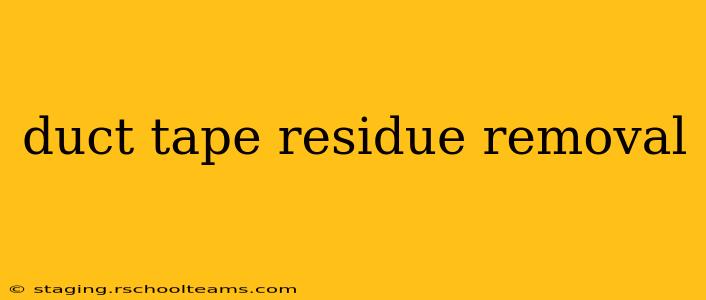Duct tape, that ubiquitous roll of handy, sticky strength, can be a lifesaver for countless projects. But once the job's done, you're left with its stubborn residue—a sticky, unsightly reminder of its usefulness. Removing duct tape residue can be surprisingly challenging, but with the right techniques, you can reclaim the pristine surface beneath. This comprehensive guide will walk you through various methods for removing duct tape residue from a variety of surfaces, ensuring you achieve a clean and residue-free finish.
Understanding the Enemy: Why Duct Tape Residue Sticks Around
Before diving into removal techniques, it's helpful to understand what makes duct tape residue so persistent. The adhesive used in duct tape is designed to be strong and durable, adhering firmly to various surfaces. This adhesive is often a blend of synthetic rubbers and resins, which can leave behind a sticky film that clings tenaciously. The longer the tape remains on a surface, the more deeply the adhesive penetrates, making removal more difficult.
Effective Methods for Removing Duct Tape Residue
The best approach to removing duct tape residue depends largely on the surface you're working with. Here's a breakdown of effective methods categorized by surface type:
Method 1: The Gentle Approach - Heat and Patience
This method works wonders for many surfaces, especially those sensitive to harsh chemicals.
- Heat Application: Apply gentle heat to the residue using a hairdryer (on a low setting) or a heat gun (use with extreme caution and maintain a safe distance). The heat softens the adhesive, making it easier to wipe away.
- Removal: After heating, gently scrape the softened residue with a plastic scraper or a credit card. A soft cloth dampened with warm, soapy water can help lift the residue.
- Surface Types: Effective on painted surfaces, wood, glass, and plastic. Caution: Avoid excessive heat, as it could damage certain surfaces.
Method 2: The Chemical Solution - Solvents and Cleaners
For tougher residues, a solvent or specialized cleaner might be necessary.
- Isopropyl Alcohol (Rubbing Alcohol): Soak a clean cloth in isopropyl alcohol (at least 70%) and apply it to the residue. Let it sit for a few minutes, then gently rub to loosen the adhesive.
- WD-40: A surprising but effective solution for stubborn residue. Spray WD-40 onto the residue, let it sit for a few minutes, then wipe away with a clean cloth.
- Commercial Adhesive Removers: Several commercial products are specifically designed to remove adhesive residue. Follow the manufacturer's instructions carefully.
- Surface Types: Effective on various surfaces but always test a small, inconspicuous area first to ensure it doesn't damage the surface. Caution: Avoid using harsh solvents on delicate surfaces.
Method 3: The Abrasive Approach - For Stubborn Residues
For truly stubborn residue that resists other methods, a more aggressive approach may be necessary.
- Baking Soda Paste: Create a paste of baking soda and water. Apply it to the residue, let it sit for a few minutes, then gently scrub with a soft cloth or sponge.
- Magic Eraser: A melamine foam eraser can effectively remove stubborn residue, but use it gently to avoid scratching the surface.
- Surface Types: Suitable for tougher surfaces like metal or certain plastics. Caution: Always test a small area first to avoid scratching or damage.
Preventing Duct Tape Residue in the First Place
Prevention is always better than cure. Here are some tips to minimize residue:
- Apply tape carefully: Avoid stretching the tape excessively, as this can weaken the adhesive and cause residue.
- Use a release agent: Apply a thin layer of petroleum jelly or silicone spray to the surface before applying the tape. This can help prevent the tape from sticking too firmly.
- Remove tape slowly and carefully: Pull the tape away slowly at a low angle to minimize the amount of adhesive left behind.
Conclusion: A Clean Slate Awaits
Removing duct tape residue doesn't have to be a frustrating battle. By following these methods and choosing the right approach for your specific surface, you can easily achieve a clean and residue-free finish. Remember to always test any cleaning solution on a small, inconspicuous area first to avoid damage. With a little patience and the right technique, you can easily conquer even the most stubborn duct tape residue and restore your surfaces to their former glory.
